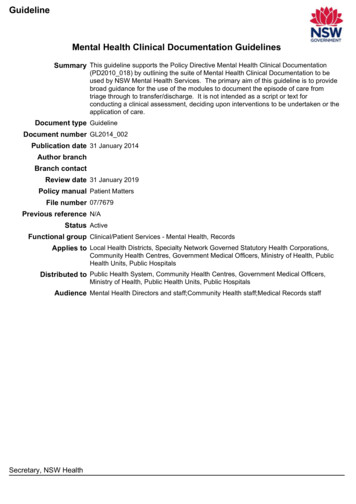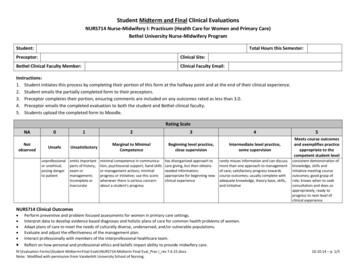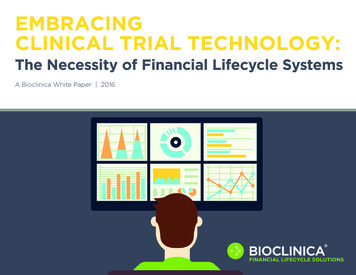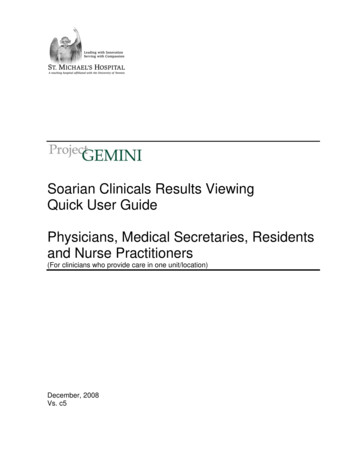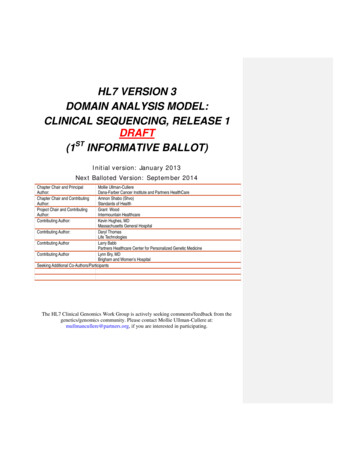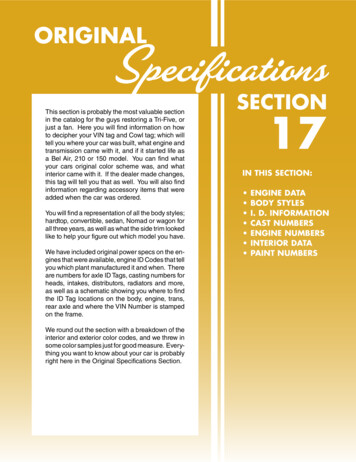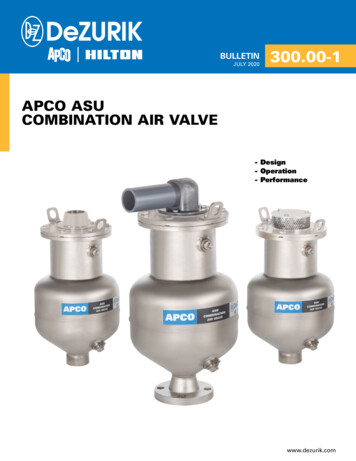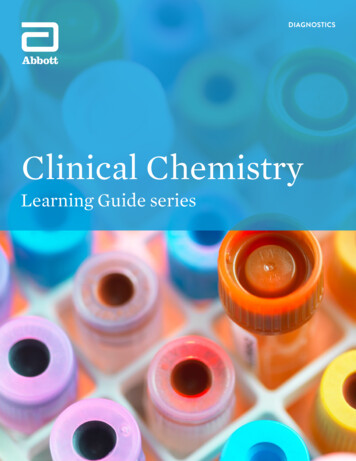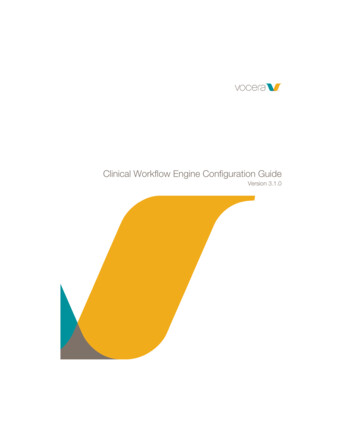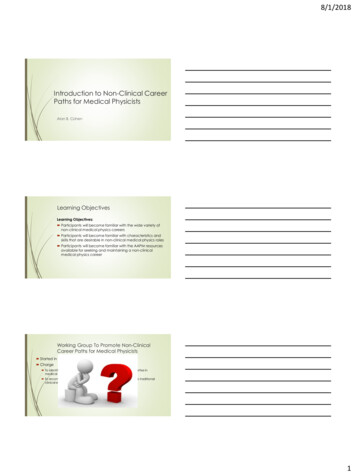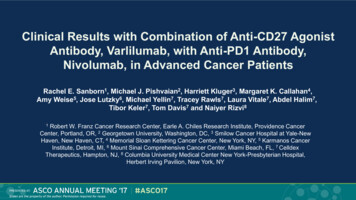
Transcription
Clinical Results with Combination of Anti-CD27 AgonistAntibody, Varlilumab, with Anti-PD1 Antibody,Nivolumab, in Advanced Cancer PatientsRachel E. Sanborn1, Michael J. Pishvaian2, Harriett Kluger3, Margaret K. Callahan4,Amy Weise5, Jose Lutzky6, Michael Yellin7, Tracey Rawls7, Laura Vitale7, Abdel Halim7,Tibor Keler7, Tom Davis7 and Naiyer Rizvi8Robert W. Franz Cancer Research Center, Earle A. Chiles Research Institute, Providence CancerCenter, Portland, OR, 2 Georgetown University, Washington, DC, 3 Smilow Cancer Hospital at Yale-NewHaven, New Haven, CT, 4 Memorial Sloan Kettering Cancer Center, New York, NY, 5 Karmanos CancerInstitute, Detroit, MI, 6 Mount Sinai Comprehensive Cancer Center, Miami Beach, FL, 7 CelldexTherapeutics, Hampton, NJ, 8 Columbia University Medical Center New York-Presbyterian Hospital,Herbert Irving Pavilion, New York, NY1
Disclosures Honoraria - AstraZenecaConsulting or Advisory Role - Amgen; ARIAD;Genentech/Roche; Peregrine Pharmaceuticals; Seattle Genetics;Celldex Therapeutics (advisory board)Research Funding - Bristol-Myers Squibb (Inst); MedImmune(Inst); MerckTravel, Accommodations, Expenses - Five Prime Therapeutics
Enhancing the Efficacy of Immune Checkpoint BlockadeNivolumab, a fully human IgG4 mAb that binds to PD-1 and inhibits PD-1/PD-L1 interactions, is approvedfor multiple indications but many opportunities to improve efficacy remainCombination strategies that target T cell costimulation molecules such as CD27 may enhance clinicalresponses to checkpoint blockadeCD27: Member of the TNF-receptor superfamily Single ligand is CD70 (tightly regulated)Constitutively expressed on most T cells and a subset of B and NK cellsCD27 activation:– Signaling through Traf2, Traf 5– Activation of the NF-κB pathway– Cell survival, activation, proliferation– Role in generation and long-term maintenance of T cell immunity– Role in NK cell differentiation/activationVarlilumab: Fully human IgG1 CD27 agonist mAb Strong preclinical data demonstrating single agent and combinationactivity in tumor models
Safety profile appears favorable in its class ofagonist mAbs; minimal toxicities; no significantimmune-mediated AEs 1, 2, 3Potent immunologic activity consistent withMOA1, 2, 3 Rapid induction of pro-inflammatory IFN-γ drivenchemokines, increased expression of T cellactivation markers, and marked decrease in Tregs without evidence of broad T cell depletionDecrease in Tregs with Varlilumabp 0.0041p .0039p ns Single-agent antitumor activity demonstrated in advanced, refractory patientswith solid tumors or hematologic malignancies (n 90)1, 2, 3 Three patients experienced objective responses Patient with HL achieved a CR after 3 cycles of varlilumab (0.3 mg/kg). Remains inremission at 33.1 months without further anticancer therapy Patient with RCC achieved a PR with varlilumab (3 mg/kg). PR persists at 2.5 yearswithout further anticancer therapy (see graph below) Patient with RCC completed 5 cycles of varlilumab (3 mg/kg) and maintained stabledisease until achievement of a single-time point PR at 4.2 years without additionalanticancer therapy Twelve patients experienced SD up to 14 monthsDurable Partial Response for a Patient with RCCLength of Target Lesion (mm) Varlilumab Clinical Experience: Phase 1 Monotherapy TrialStudy Month1 Bullock,et al. SITC 2014Infante, et al. ASCO 20143 Burris, et al, JCO 20172
Phase 1/2 Study of Varlilumab in Combination with NivolumabPhase 1: Dose escalation/expansion of varlilumab (0.1, 1, and 10 mg/kg) with nivolumab 3 mg/kg 6 initial patients per cohort, with option for expansion to15 patients Key eligibility criteria: Recurrent or refractory SCCHN, ovarian cancer, melanoma,NSCLC, or CRC Documented progressive disease 5 prior anticancer regimens for advanced disease 3 month washout for anti-CTLA-4 or other T cell directed mAbs No prior anti-PD-(L)1 therapy No active, untreated CNS metastases No autoimmune disease Objectives: Primary: safety and tolerability, identify varlilumab doses forPhase 2 cohorts Secondary: DOR, TTR, PFS, OS, Immunogenicity and PK Exploratory: Pharmacodynamic effects on peripheral bloodand tumor markersCycle 1Cycle 2Cycle 3Cycle 4 Tumor biopsies at baseline and onstudy (4-6 weeks)Restaging ScansNivolumabVarlilumab Four 8-week cycles of combinationtherapy, followed by nivolumabmonotherapy02468101214 161820Week22 242628 30 32 343638 40 Treatment until dose-limiting toxicityor disease progressionPhase 2: Tumor-specific cohorts (CRC, GBM, Ovarian, SCCHN, and RCC) to evaluate clinical activityof selected varlilumab dose(s) and schedules with nivolumab flat dose (240 mg)NCT02335918
Baseline Patient CharacteristicsAge, years (median [range])Male (n [%])Primary Diagnosis (n [%])CRCOvarianMelanomaSCCHNECOG performance status (n [%])01Stage IV at Study Entry (n [%])1No. of prior treatment regimens (median [range])Prior immunotherapy (n [%])PD-L1 tumor (n/n [%])21 Two20.1 mg/kg(n 6)66 (57-76)3 (50)1 mg/kg(n 15)54 (40-66)8 (53)10 mg/kg(n 15)50 (29-84)7 (47)All Phase 1(n 36)57 (29-84)18 (50)5 (83)1 (17)008 (53)4 (27)1 (7)2 (13)8 (53)3 (20)3 (20)1 (7)21 (58)8 (22)4 (11)3 (8)2 (33)4 (67)5 (83)3 (2-4)1 (17)0/6 (0)3 (20)12 (80)15 (100)4 (0-9)1 (7)1/11 (9)9 (60)6 (40)14 (93)3 (0-8)1 (7)2/11 (18)14 (39)22 (61)34 (94)3 (0-9)3 (8)3/28 (11)stage III patients were ovarian cancer (0.1 mg/kg group) and SCCHN (10 mg/kg group).Denominator represents patients with tumor assessed for PD-L1 status. PD-L1 criteria: 1% tumor cells stainingpositive, using the BMS developed PD-L1 IHC method at a central lab
Varlilumab & Nivolumab Combination Therapy is Well Tolerated All dose levels well tolerated, withoutidentification of a maximally tolerated dose No evidence of additive toxicity for thecombination of varlilumab with nivolumab 3 patients discontinued the study due totreatment related AEs 3 patients with treatment-related* SAEs (all10 mg/kg varlilumab):– Peripheral sensorimotor neuropathy (grade 2)– ALT increased (grade 3)– Acute kidney injury (grade 3) and hepatitis (grade 4and a dose-limiting toxicity)*The above SAEs were related to varlilumab and nivolumabTreatment-Related Adverse EventsAll Phase 1 (n 36)Any Severity Grade 3Any treatment-related adverse event31 (86%)10 (28%)Infusion related reaction10 (28%)0Fatigue10 (28%)0Lymphopenia9 (25%)6 (17%)Pruritus8 (22%)0Rash11 (19%)1 (3%)Nausea7 (19%)0Arthralgia5 (14%)0Pyrexia4 (11%)0Vomiting4 (11%)1 (3%)ALT increased4 (11%)2 (6%)*AST increased3 (8%)1 (3%)*2 (6%)2 (6%)Lipase increased1 (3%)1 (3%)*Acute kidney injury1 (3%)1 (3%)Amylase increased1 (3%)1 (3%)*Autoimmune hepatitis1 (3%)1 (3%)*Blood alkaline phosphatase increased1 (3%)1 (3%)*Blood bilirubin increasedTable includes adverse events assessed as related to either varlilumab ornivolumab for 10% of patients overall, or at grade 3 severity any patient.* 1 patient had all AEs (excluding 1 incident of ALT increased)
Tumor Response100Best Response:PRuPRSDPD500X New LesionEnd of TreatmentPD-50-1000102030Week405060% Change from Baseline(RECIST 1.1 Target Lesions)% Change from Baseline(RECIST 1.1 Target Lesions)0.1 mg/kg varlilumab and 3 mg/kg nivolumab1501 mg/kg varlilumab and 3 mg/kg nivolumab150100Patient with PD-L1-negative CRC(pMMR) achieved PR (95%shrinkage) and continues toreceive treatment at 22 months.500-50CRC-100010203040Week5060% Change from Baseline(RECIST 1.1 Target Lesions)10 mg/kg varlilumab and 3 mg/kg nivolumab150100Patient with low PD-L1 (5%) SCCHN achieved PR(59% shrinkage) and experienced PFS of 6.7 months.500Patient with PD-L1-negative ovarian cancer experienced asingle-time point PR (49% shrinkage; uPR) at 1.6 months,but discontinued treatment due to a DLT.-50-1000102030Week405060Disease Control Rate* 0.1 mg/kg varli nivo: 1 mg/kg varli nivo: 10 mg/kg varli nivo:1/5 (20%)5/15 (33%)6/15 (40%)* DCR; best response of SD or better 3 months
Durable Response in MMR-proficient CRC Patient4-23-2015 (Baseline)6-29-2015 (Cycle 1)3-06-2017 (Cycle 12)Liver PD-L1-negative, pMMR colorectaladenocarcinoma with metastaticdisease to liver, adrenal gland,abdomen and mesenteric nodule1 2 prior chemotherapy basedregimens (1 with EGFR targetedtherapy) On study, had a 95% decrease intarget lesions, including resolutionof 4/5 target lesions. One 6 mmmesenteric nodule remainsAdrenal Completed all 4 cycles ofvarlilumab and nivolumab therapyand continues to receivenivolumab monotherapy at 22 months1Expectedresponse rate for nivolumab in MSI-low (pMMR) CRC is 0% (Overman, et al, ASCO 2016) Treatment-related toxicity limitedto grade 1 pruritus, fatigue, chillsand fever
Extensive Immune Monitoring Incorporated into the Study Peripheral blood: serum factors, flow cytometry Peripheral blood analysis– Prominent decrease in CD4 and Tregcells observed across all cohorts– Serum chemokine changes consistentwith varlilumab monotherapy Transient increase in inflammatorychemokines (CXCL10, MCP-1, MIP1β and MIG) observed across allcohortsThe correlative analysis contains patients from Phase 1and patients with data from Phase 2% Change from Baseline Tumor biopsies: baseline and on-treatment -68%-18%Median:Median:-54%-10%-72%4%-76%32%
Immunohistochemistry of Biopsy SamplesBaseline biopsies were generally low in T cell markers and PD-L1 expression on tumor% Positive CellsAll Screen DataBaselineSpecimensBaselineExpressionExpression inin BiopsiesBiopsy Specimens T cell infiltrates and PD-L1expression increasedsignificantly during treatmentin some patientsMedian:8.151.358.2% 1.4%3.793.8%0.981.0%00%0.983.961.0 % 4.0%00%11.8611.9%Includes patients from Phase 1 (n 28) and Phase 2 (n 37)Median This was particularly evidentin a sub-group analysisfocused on ovarian patients
Tumor Expression of PD-L1 is Increased in Ovarian Patients Baseline biopsies were generally negative or low PD-L1 positive– 10 of 26 (38%) had PD-L1 tumors; range 1%-15% (mean 5.1%) Patients with paired biopsies (n 13):– 2 of 13 patients were positive at baseline (10%, 15%)– 10 of 13 (77%) were PD-L1 on-treatment (4-6 weeks); range 1-65% (mean 20.8%)BaselineOn-treatmentPD-L1 testing was performed using the BMS developed PD-L1 IHC method (Dako clone 28-8);PD-L1 defined as 1% of tumor cells
Enhanced PD-L1 Expression and CD8 TIL in Ovarian PatientsSD or better (n 6)P 0.01560402060PreOTP 0.05540302010040200PreOT80P 0.0181PreOT2403020100PreOTP 0.286040200PreOTP 0.816050( % Pos. Cells)( % Pos. Cells)CD8606050P 0.027( % Pos. Cells)080( % Pos. Tumor Cells)PD-L1( % Pos. Tumor Cells)80PD and 16 wks SD (n 7)( % Pos. Tumor Cells)All (n 13)5040Ovarian patients withpaired baseline and ontreatment biopsies to datePhase 1 patients n 630Phase 2 patients n 720100PreOTP value: 2-tailed Paired T-Test
Optimization of Dosing RegimenOvarian Patient with SD Chronic CD27 stimulation may not be optimal– Evidence of T cell infiltration, but also PD-1expressionRed CD3– Potential for immune exhaustionGreen PD-1 Alternate dosing regimens selected using receptoroccupancy data and PK modelingBaseline 21% PD-1 Varlilumab, µg/mlContinuous saturation or clearance following high or low dose of varlilumab3 mg/kg Q2wk1003 mg/kg 20014284256Days7084980112 0Planned Phase 2 Cohorts:0.3 mg/kg Q4wk100OT 69% PD-1 CRC (n 18), GBM (n 20) and RCC (n 25):varlilumab 3 mg/kg q 2 weeks Ovarian and SCCHN: Varlilumab 3 mg/kg q 2 weeks (n 18) Varlilumab 3 mg/kg q 12 weeks (n 18) Varlilumab 0.3 mg/kg q 4 weeks (n 18)14284256708498112 All receive nivolumab flat dose (240 mg) q 2weeks
Conclusions and Next Steps The combination of varlilumab and nivolumab was well tolerated at all varlilumabdose levels tested The majority of tumors were PD-L1 negative at baseline and 80% of patientsenrolled in Phase 1 had CRC or ovarian cancer– Representing patient populations expected to have minimal response tocheckpoint blockade Clinical responses were observed in the Phase 1 portion of the study, including adurable partial response in a patient with pMMR CRC Increase in CD8 TILs and tumor PD-L1 expression in some patients– In ovarian patients, trend for better disease control Alternative varlilumab dosing regimens added to the study to explore intermittentCD27 signaling
AcknowledgmentsThank you to the patients who participated in this study Study CDX1127-02 investigatorsand their staff–––––––––––Rachel SanbornMichael PishvaianMario SznolMargaret CallahanAmy WeiseJose LutzkyNaiyer RizviToni ChoueiriBranimir SikicJeanny Aragon-ChingAlexander Starodub homas DavisTibor KelerMichael YellinTracey RawlsLaura VitaleAbdel HalimThomas HawthorneJennifer NewmanElsa ParadiseRenee RiggsTheresa BelottiYi HeHui ZhangTianshu Li Bristol-Myers Squibb––––Steven AverbuchSutapa MukhopadhyayWendy ClemensAlexander Cao
Two stage III patients were ovarian cancer (0.1 mg/kg group) and SCCHN (10 mg/kg group). 2 Denominator r
